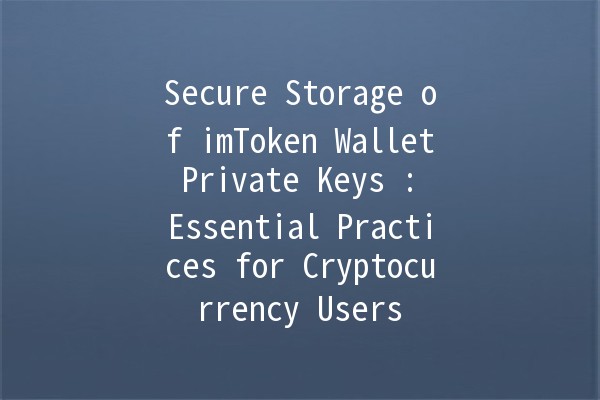In the fastevolving world of cryptocurrency, the security of private keys is paramount, especially for users of wallets like imToken. Private keys are the gateway to accessing and managing your digital assets, making it crucial to store them securely. Below, we’ll explore comprehensive techniques to ensure the safe storage of your imToken wallet private keys, which can help protect your funds from unauthorized access and theft.
Before diving into the specific storage techniques, it’s essential to understand why safeguarding your private keys is crucial. If someone gains access to your private key, they have full control over your cryptocurrencies. This can lead to irreversible losses, as transactions on the blockchain are permanent and cannot be undone. Therefore, taking the necessary precautions to protect these keys is a responsibility that every cryptocurrency user must undertake.

Overview:
Hardware wallets are physical devices specifically designed to store private keys securely offline. They provide an excellent solution for longterm cryptocurrency storage as they are less susceptible to online threats.
Implementation Example:
Investing in wellknown hardware wallets like Ledger or Trezor allows you to generate and store your private keys offline. Similar to keeping cash in a safe, this method protects your assets from hacking attempts and malware that could affect your computer or mobile device.
Overview:
A paper wallet is a form of cold storage that involves printing your private key and public address on paper. This method keeps your keys offline and safe from digital attacks.
Implementation Example:
You can generate a paper wallet by using trusted sites like Bitaddress.org, ensuring the computer is secure and offline during the process. After printing, store the paper wallet in a secure place, such as a safe deposit box, to ensure it remains protected from physical damage or theft.
Overview:
While 2FA doesn't directly protect your private key, it adds an extra layer of security to your wallet and associated accounts. This makes it significantly harder for attackers to access your wallet even if they have your password.
Implementation Example:
Ensure to link your imToken wallet to a 2FA app, such as Google Authenticator or Authy. Every time you log in, you’ll also need to verify your identity through a second method, making unauthorized access much more difficult.
Overview:
Running outdated versions of the imToken app or any related software can expose you to vulnerabilities that hackers exploit. Regular updates often include security patches that protect your wallet.
Implementation Example:
Set reminders to check for updates frequently or enable automatic updates for the app. This not only helps protect your private key but also enhances your overall user experience with new features and improvements.
Overview:
Your password is the first line of defense against unauthorized access to your wallet. Utilizing a strong and unique password significantly enhances your security.
Implementation Example:
Create a password that includes a mix of upper and lowercase letters, numbers, and special characters. Additionally, it’s advisable to use a password manager to generate and store your passwords securely, ensuring you never recycle passwords across different accounts.
Creating and managing backups of your private keys is crucial for securing your assets. In the event of device failure or loss, having a reliable backup can mean the difference between accessing your funds and permanently losing them.
Export or Write Down: After generating your wallet, export your private key and public address or write them down on paper.
Store in Multiple Locations: Keep backups in several secure physical locations (like a safe or safety deposit box) and consider encrypting digital copies that you store on a USB drive.
Test the Backup: Regularly test your backups to ensure you can access your private keys whenever needed. This proactive approach prevents unforeseen access issues during emergencies.
If you realize that your private key has been exposed, immediately transfer your cryptocurrencies to a new wallet with a new private key. This action secures your assets and minimizes the risk of theft.
Yes, using imToken or any financial application on public WiFi can expose you to risks, including maninthemiddle attacks. If you must use public networks, employ a virtual private network (VPN) to encrypt your connection and reduce exposure.
Storing private keys digitally carries risks of hacking and malware. If you choose to store keys digitally, use encrypted files and secure your computer with uptodate antivirus software. However, cold storage methods like hardware and paper wallets are generally safer.
Ensure that your wallet has enabled security features like 2FA, has the latest app updates installed, and you regularly monitor your account activity for any unauthorized transactions.
Private keys cannot be recovered; this is why creating backups is vital. If you lose your private key without a backup, your funds are permanently inaccessible. Therefore, always consider your key as essential as the funds themselves.
A good paper wallet will be generated offline using a trusted tool and printed with a clear, legible representation of the private key and public address. To enhance security, store it in a location that minimizes the risk of theft or damage, such as a safe.
Protecting your imToken wallet and its private keys requires vigilance and best practices to mitigate risks associated with cryptocurrency storage. By implementing these strategies and regularly reviewing your security measures, you can maximize your chances of safeguarding your assets effectively. Remember, in the world of cryptocurrencies, being proactive about security can save you from significant financial losses in the future.